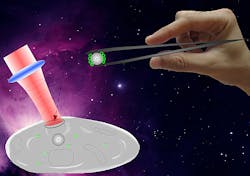Optical tweezers, ultrafast laser pair to gently insert DNA into living cells
Current methods for inserting DNA into living cells don't allow precise control of how and when to insert it or require burning through large numbers of cells before getting it into one cell. Recognizing this, a team of scientists at the Gwangju Institute of Science and Technology (Gwangju, South Korea) has developed a method that allows them to precisely poke holes on the surface of a single cell with a high-powered femtosecond laser and then gently tug a piece of DNA through it using optical tweezers, which draw on the electromagnetic field of another laser.
Related: Optical fiber 'wrench' controls ultra-small cells, DNA
"Until today, gene transfection has been performed on a large quantity of agglomerate cells and the outcome has been observed as a statistical average and no observations have been made on individual cells," says Yong-Gu Lee, an associate professor in the School of Mechatronics at the Gwangju Institute of Science and Technology in South Korea and one of the researchers who carried out the study.
In the new study, the researchers sought to safely transfect an individual cell. To manipulate the foreign DNA, the scientists used optical tweezers, which essentially tweak a laser beam whose electromagnetic field can grab hold of and transport a plasmid-coated particle. The researchers first moved the particle to the surface of the cell membrane. Guided by the trapped particle, they then created a tiny pore in the cell membrane using an ultrashort laser pulse from a femtosecond laser. While another laser beam detected the exact location of the cell membrane, they pushed the particle through the pore with the tweezers. Using this technique, the scientists were able to ease a microparticle right up to the pore in the membrane and drop it into the cell.
To determine whether their method had succeeded, the researchers inserted plasmids carrying a gene that codes for a green fluorescent protein. Once inside the cell, the gene became active and the cellâs machinery began producing the protein. The researchers could then detect the green glow using a fluorescence microscope. They found that approximately one in six of the cells they studied became transfected. This rate is lower than that recorded for some other methods, but those are less precise and involve many cells at a time.
Lee hopes the work will allow other researchers to investigate the effects of transfection on individual cells, not just large populations. With the new technique, âyou can put one gene into one cell, another gene into another cell, and none into a third,â he says. âSo you can study exactly how it works.â
The teamâs approach has been published in the journal Biomedical Optics Express; for more information, please visit http://www.opticsinfobase.org/boe/abstract.cfm?uri=boe-4-9-1533.
-----
Follow us on Twitter, 'like' us on Facebook, and join our group on LinkedIn
Subscribe now to BioOptics World magazine; it's free!


